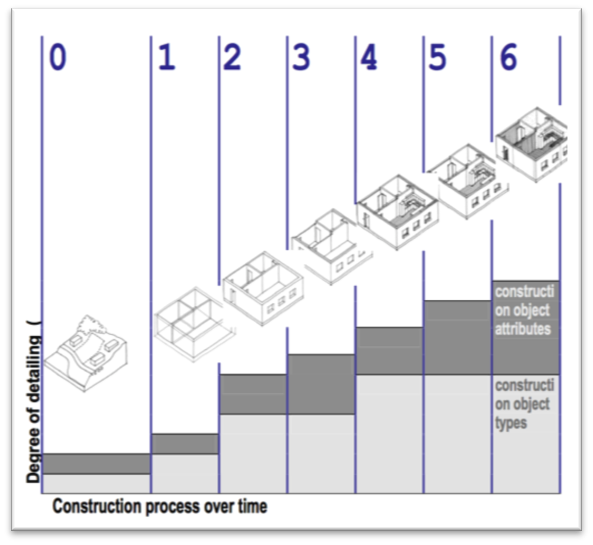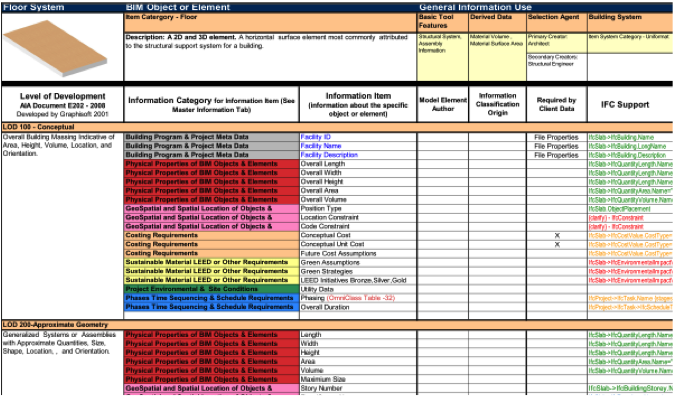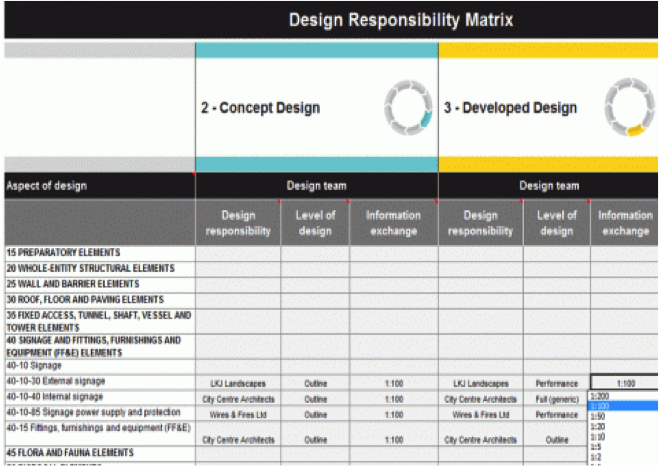This is an extract of a publication by Berlo, Bomhof and Korpershoek.
The Danish Information levels
In Denmark, a package of guidelines regarding 3D was developed in 2006. This was accomplished under the Digital Construction program initiated by the Danish Enterprise and Construction Authority. In June 2006 the Danish BIPS published the document “3D Working Method 2006” (Bips 2007).
The Danish method is built up on the principle of evolving detailing. Each party will add information to the discipline model at a higher and higher level successively through the process and thus work with rising information levels within its discipline. The modelled construction objects are refined geometrically and functionally and a number of object attributes are added and specified further during the process.
On transition from one agreed phase to the next, the discipline model is locked, with a status corresponding to the current information level. This information level is the starting point for modeling in the next phase. The Danish concept uses seven information levels. The method can be adapted to traditional phasing of construction, but does not exclude the option, on a specific project, of using another division of processes and responsibilities in terms of time and content. More or fewer information levels, and different constellations of information levels between the discipline models can be used (Berlo,et al 2012).
The seven levels correspond roughly to the traditional construction phases, but the levels can be customized to other phased processes and methods, and the allocation of roles can vary in accordance with the nature of the task (Bips 2007).
Vico Model Progression Specification
Vico Software (then a division of Graphisoft) began work in 2004 on a Model Progression Specification (MPS). The core of the MPS is the “Level of Detail” definitions—descriptions of the steps through which a BIM element can logically progress from the lowest level of conceptual approximation to the highest level of representational precision. The 5 levels are: Conceptual (100), Approximate geometry (200), Precise geometry (300), Fabrication (400), As-built (500). LOD identifies how much information is known about a model element at a given time.
AIA LOD
The AIA California Council IPD committee and the AIA Contract Documents Committee adopted the LOD concept as the core of its E202-2008 Building Information Modeling Protocol (AIA 2008). This committee evolved the LOD concept into “Level of Development”. In 2008, the AIA developed its first set of Level of Development definitions in AIA Document E202™-2008 Building Information Modeling Protocol. Due to the rapidly evolving nature of the use of BIM, the AIA evaluated the E202–2008, including the LOD definitions. The result is the updated and reconfigured Digital Practice documents, AIA E203™–2013, Building Information Modeling and Digital Data Exhibit, AIA G201™–2013, Project Digital Data Protocol Form, and AIA G202™–2013, Project Building Information Modeling Protocol Form, which are accompanied by a detailed guide document entitled Guide and Instructions to the AIA Digital Practice Documents. The AIA’s updated Digital Practice documents include revised LOD definitions.
BIMforum LOD
To help further the standardization and consistent use of the LOD concept, and to increase its usefulness as a foundation for collaboration, the AIA agreed to allow BIMForum.org to utilize its latest LOD definitions in this Specification. In early 2011, the LOD Working Group was formed under the auspices of the BIMForum and began developing the LOD framework into a consensus-based document. The LOD definitions that are used in this document are identical to those to be published in the AIA’s updated Digital Practice Documents, with two exceptions.
First, the working group identified the need for an LOD that would define model elements sufficiently developed to facilitate coordination between disciplines—e.g., clash detection/avoidance, layout, etc. The requirements for this level are higher than those for 300, but not as high as those for 400, thus it was designated LOD 350. The AIA documents do not include LOD 350, but the associated Guide and Instructions references it.
Second, while LOD 500 is included in the AIA’s LOD definitions, the working group did not feel it was necessary to further define and illustrate LOD 500 in this Specification because it relates to field verification. Accordingly the expanded descriptions and graphical illustrations in this Specification are limited to LOD 100-400 (BIMforum.org, 2013).
The first draft of the resulting Level of Development Specification was released for public comment at the Miami BIMForum on April 2013.
US veterans affairs and 2010 and Australia’s NatSPEC 2011
To facilitate BIM development, in 2010 the US Veterans Affairs has provided the Object Element Matrix that defines object and element properties and attributes by Uniformat/OmniClass classification and Level of Development (LoD) (VA 2010). It is a spreadsheet to be used for identifying and tracking BIM information during the project. It depicts Building Information Typologies/Types, when they are relevant, and to what level of development (LOD) throughout a building lifecycle. It is an expansion of AIA Document E202 BIM Protocol Exhibit to support a greater level of understanding of BIM information use. The initiative and spreadsheet were adopted by Australia’s NatSPEC in its BIM Object/Element Matrix (Natspec 2013).
UK RIBA, BSI and NBS
In the UK BSI published PAS 1192-2 (Specification for information management for the capital/delivery phase of construction projects using building information modeling) in 2013. This document defines the following abbreviations:
– A.77 levels of model detail (LOD): Description of graphical content of models at each of the stages defined for example in the CIC Scope of Services.
– A.78 levels of model information (LOI): Description of non-graphical content of models at each of the stages defined for example in the CIC Scope of Services.
The document shows the level of graphical and non-graphical information slowly developing throughout the project (alongside additional documentation).
The RIBA Plan of Work was published in 2013. As part of Stage 1 “Preparation and Brief”, one key task that should take place before design begins is the production of a Design Responsibility Matrix. NBS has developed several tools to support the production of this document.
Private excel sheets
Several private BIM modeling companies have all created their own so called “demarcation” lists. This (mostly spreadsheet) lists define the border of what should be modeled in a particular phase of the process. These initiatives also show the necessity to define what information is needed to perform a specific given task. The current definition of LOD concepts is not explicit enough for this.
General/overall conclusion
There seems to be a consensus that a focus on geometry (“Level of Detail”) isn’t the key issue. Years ago already the LOD abbreviation was changed to “Level of Development” making geometry and non-geometric information equally important. Although the Danish had this covered already in 2006. The LOD concept gained traction with the AIA document. This initiative was focused on Integrated Project Delivery (IPD) and missed some tools to apply the LOD concept in other projects. With the comprehensive spreadsheet from the US Veterans affairs’ minimum BIM requirements release, the concept was made applicable for practice. However, most practitioners lost themselves in filling out huge spreadsheets without actually thinking about why they were doing it. Today initiatives like BIMforum.org and the UK initiatives agree that the concept should be used as a guideline to define project responsibilities and expectations in a project.
References
AIA (2008). “AIA Document E202 BIM Protocol Exhibit.” The American Institute of Architects. US.
Beetz, J., Berlo, L.A.H.M. van., Laat, R. de., Bonsma, P. (2011) “Advances in the development and application of an open source model server for building information” CIB W78, Nice.
Berlo, L.A.H.M. van, Beetz, J., Bos, P., Hendriks, H., and van Tongeren, R. C. J. (2012). “Collaborative engineering with IFC: new insights and technology.” Proceedings of the 9th European Conference on Product and Process Modelling. Iceland.
BIPS (2007). “3D Working Method 2006”, Translated to English and published in 2007, ISBN 978-87-7293-110-3, Denmark.
RGD (2013). “Rgd BIM Norm.”, version 1.1, Rijksgebouwendienst. https://www.rgd.nl/fileadmin/redactie/Onderwerpen/Diensten/BIM/Rgd_BIM_Norm_v1.1.pdf>(Jan, 2013)
NatSPEC (2013) “NATSPEC BIM Object/Element Matrix”, NATSPEC National BIM Guide, https://bim.natspec.org/index.php/natspec-bim-documents/national-bim-guide>(Jan 2014)
VA (2010). “The Object Element Matrix.” Department of Veterans Affairs (VA) Office of Construction & Facilities Management (CFM), https://www.cfm.va.gov/til/bim/BIMGuide/downloads/oemf.xls>(Jan 2014)



